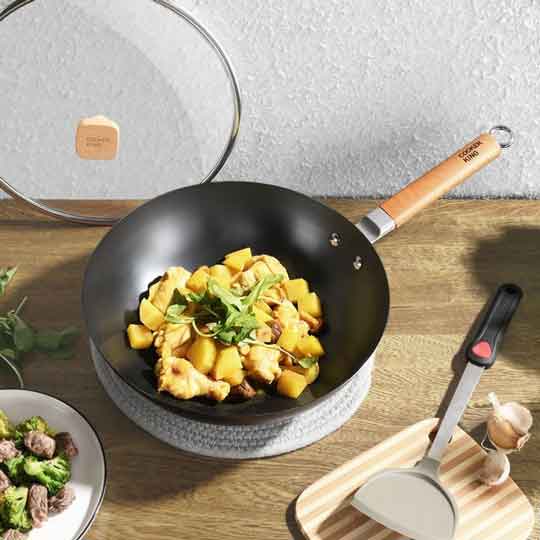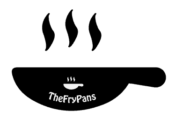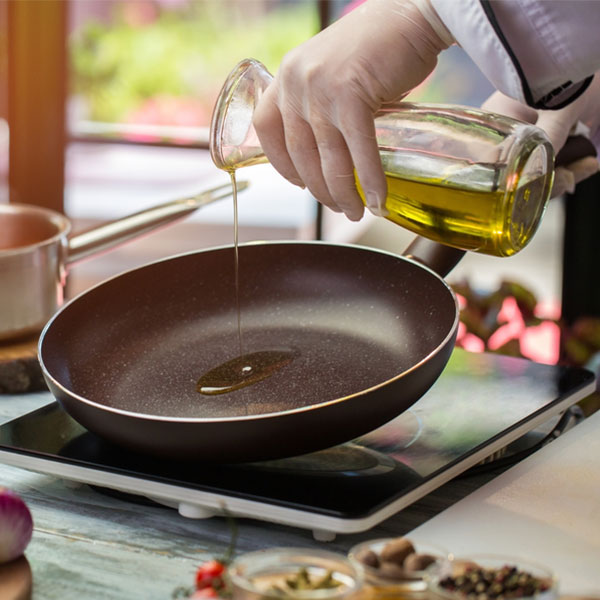A frying pan is a flat-bottomed pan with a long handle or small side handle which generally used for frying, seasoning, and grilling foods. It is typically 8 to 12 inch in diameter with relatively low sides that flare outwards, a long handle, and no lid. Larger pans sometime may have a small handle opposite the main stem.
Different Types of Frying Pan Materials
There are different materials types for fry pans. Whether it’s non-stick or not. Here we are describing a few types of fry pan material
- Aluminum – Some of Aluminum fry pans are originally created by a solid block of aluminum, on the other hand, some of them you will find with only an Aluminum coating. But the main feature is both types are excellent for heat conduction proper cooking.


- Cast Iron– Cast iron fry pans are heavy and durable. You can say it’s a lifetime investment. But a new cast iron frying pan is not always non-stick but if season it properly then it will be nonstick perfectly. Normally a cast iron frying pan takes bit more time to heat up but it distributes the heat properly and evenly.
- Carbon Steel – Carbon steel frying pans are lightweight and easy to use. Its conducts heat faster and more evenly than other similar material. It’s nonstick, handy and durable. Basically, it’s the chefs’ chosen for its versatility.
- Copper-Copper fry pans have been used for around 9,000 years. copper made pans are ideal heat conductors, even heating, durability, hygiene. It is known that copper pans conduct heat five times better than any other materials. There is a disadvantage that is costly and can be dent easily.
- Stainless Steel-Long-lasting, classic, uncoated stainless steel is a good choice for browning and braising. Often sold in sets, stainless steel cookware can be the kitchen workhorse, tackling everything from pickling to pasta sauce.
- Ceramic frying pan is a new generation of frying pans that are gaining popularity among chefs and homemakers alike. Their cooking efficiency and other useful features set them apart from the competition.
Frying Pan Features Comparisons
| Aluminum | Cast Iron | Carbon steel | Copper | Stainless steel | |
|---|---|---|---|---|---|
| Heat Distribution | Moderate | Good | Moderate | Below moderate | Moderate |
| Non-Stick Feature | Perfect non- stick | Need to season | Need to season | Moderate | Not non-stick |
| Chemical Conduction | Yes | No | No | No | No |
| Dishwasher Safety | Yes | No | Yes | No | Yes |
| Cost | Moderate | Inexpensive | Moderate | Expensive | Moderate |
| Stove Compatibility | Suitable for all type of stoves and oven | Suitable for all type of stoves and oven except glass top | Suitable for all type of stoves and oven | A few options | Suitable for all type of stoves and oven |
| Weight | Light | Heavy | Moderate | Heavy | Light |
Frying Pan Care and Use
While it is generally recommended to refer to the cleaning instructions from the product’s manufacturer, the below information outlines general care and use guidelines.
- It’s not good to leave empty frying pans on the heat source.
- For a long life clean your frying pan when it cools down properly.
- Use plastic or rubber spoons for nonstick frying pans.
- It’s better to wash by hand for long durability.
- Allow it to air dry properly before storing it.
- Use normal water and mild liquid soap for cleaning.
- It is better not to scrub the interior with hot water for non-stick and seasoned frypans.
Season a Frying Pan
The season is basically the process to make any raw fry pan non-stick by installing a light coat inside of a non-coated aluminum, stainless steel, or carbon steel frying pan.


- Apply a small amount of vegetable oil inside of the fry pan.
- Place the frying pan on a burner for 10-15 minutes at medium heat.
- Turn off the burner when the shortening turns a deep brown colour.
- Allow the pan to cool and then wipe the oil.
Your fry pan is ready to go. This process increases pans’ durability. Clean the seasoned pan with mild soap and you can repeat the process after a long use for again better results.
Frying Pan Buying Considerations:
- Surface Material: Choose your fry pan material based on your stove type and what type of food you need to cook. For example cast iron is best for roasting, stainless steel is suitable for almost all-purpose cooking.
- Handle: Along with the fry pan material its handle material is also needed to consider because oven and dishwasher safety depends on its handle material. Metal or silicone-coated handles easily compatible with the oven to the gas stove. Silicon and wood handles stay cool during stove cooking.
- Edge: Comparatively round and the high edge is suitable for liquid cooking and shallow and straight edge are good for frying and tasting foods.
- Revets: It is the joining pattern between the pan body and handles .hese parts can be joined by welding or fastening with screws.
- Lids type: Before buy your fry pan need to check if it comes with a lid or not? Justify with your need and give concern about the lid material because the glass lid is not compatible with the oven sometimes.
- Frying Pan Thickness: it is important to consider the thickness of the frying pans you are buying. The thickness or diameter of fry pan is generally measured by mils. The relation between mils and inch 1 mil is equal to 0.001 of an inch. so the higher the mil, the thicker the metal.
Frequently Asked Questions
Which fry pans are the best?
We have picked 5 best frying pans depending on the performance, user reviews and the feature of the frying pans. here are the top 5 fry pans list below.
What is the best nonstick frying pans?
There are many non-stick fry pans on the market from them we have picked the best 3 frying pans depending on the user reviews and the feature of the frying pans. Here are the top 3 non-stick frying pans are listed below.
What is the difference between a skillet and fry pan?
A skillet is a pan with slanted sides. To add to the confusion, this pan is also sometimes called a frypan or frying pan. The slanted sides make this pan perfect for stir-frying and quick cooking techniques where you’re moving ingredients around a lot in the pan. It’s also good for dishes like frittatas that are served straight from the pan.
What frying pans do chefs use?
We asked chefs and cookware professionals for their thoughts and choices while cooking with frying pans, and concludes that chefs use different types of fry pan while preparing a different kind of recipes. Chefs use Aluminum Fry Pans, Stainless Steel Frying Pans, Copper Frying Pans, Cast Iron fry Pans and each one has its distinct qualities and benefits.
Do chefs use non-stick pans?
Yes, they use non-stick pans for eggs. And their metal utensils come nowhere near those pans. Those pans go nowhere near the dish pit. They get cleaned by hand and stacked with towels in between to preserve that coating. As soon as the eggs begin to stick to the pan, a new container brought in. That is pretty much the only reason for non-stick in a professional kitchen.
Is it safe to use non stick pans?
Most nonstick pans are coated with Teflon. There are a lot of rumours out there that Teflon is toxic and that these pans may not be safe to use.
Non-stick pans don’t make fond, or not very much unless you turn the heat up so high that you burn the food and atomize the non-stick coating. Now you’ve ruined a pan and poisoned your food!
Besides that, non-stick pans are often cheap and poorly made. Food does not heat evenly, handles quickly become wobbly, the non-stick coating peels off, etc. And being professionals, chefs know how to keep things from sticking unless they want them to.

